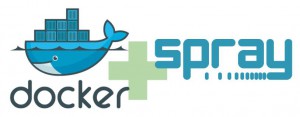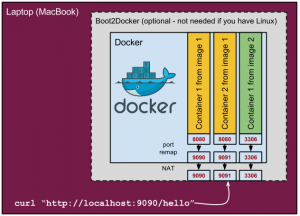Docker — довольно новый, но очень захватывающий проект; С помощью Docker вы можете создавать легкие автономные контейнеры с любым приложением внутри, а затем запускать контейнеры на различных хостах. Один и тот же контейнер можно запускать как локально, так и на производстве в больших масштабах. Более того, работа с контейнерами происходит быстро и не требует больших затрат памяти, процессора и дискового пространства.
«Любое приложение» может, конечно, также означать сервер на базе Java! В этом примере мы создадим образ Docker, на котором работает простой REST-сервер, реализованный с использованием превосходного инструментария Spray , который сам основан на Akka и реализован в Scala .
Сервер (на основе спрея)
Источники проекта можно найти на GitHub . Проект сервера состоит из одного исходного файла DockedServer . Это DockedServer объект, расширяющий эту App черту, что означает, что он работает как класс java верхнего уровня и имеет автоматически определенное значение public static void main(...). Внутри класса мы запускаем сервер, который связывается 0.0.0.0:8080и обслуживает три типа запросов:
GET /helloGET /counter/[name]POST /counter/[name]?amount=[number]
Apart from a simple hello-world server, you can also see how Spray integrates with Akka actors, Futures and how type-safe parameter handling works.
The project is built with sbt; the build file is fairly simple. It uses the sbt-assembly-plugin to generate a single, runnable, fat-jar (notice the mainClass and assemblySettings settings). No (servlet) containers, or application servers, just a simple jar!
Hence, after cloning the repository, if you run sbt assembly, in the target/scala-2.11 directory you should see a docker-spray-[...].jar file, which you can run with:
java -jar docker-spray-[...].jar
and test if the server works locally:
curl "http://localhost:8080/hello"
Creating a Docker image
Now that we have a runnable jar, we can create a Docker image. The image will contain the Spray-based server, and all required OS-level dependencies (e.g. Java). The image will be runnable on any host with Docker installed (the host can have any configuration), without any need for further modification.
Firstly we need Docker of course; Docker has a great interactive tutorial and reference/installation instructions, so I recommend reading these to understand the basics.
As I use OSX, to install the docker daemon I had to use the boot2docker wrapper, which manages a VirtualBox Ubuntu VM. Inside the VM the Docker daemon runs, and the VM serves as the host for running docker containers. All of that is covered in the installation instructions, and boils down to a single brew install command. You don’t need that additional step if you are running Linux.
To create an image, the most convenient option is to write a Dockerfile, which describes the steps required to create the image from scratch. The Dockerfile for our example is quite short. First we specify that the base image is going to be dockerfile/java, a “trusted” Ubuntu build which has java 7 installed.
You can think of Docker as “Git for vm images”. After each statement from the Dockerfile is processed, a commit is made, which can then be used as a base for creating another image (correspond to branching). That’s exactly what we are doing with dockerfile/java(forking/branching off that repository).
Other important statements are:
ADD, which copies the fat-jar to the imageENTRYPOINT, which specifies what command should be run when the image is run (makes the image behave almost as an executable)EXPOSE, which exposes a port from the container to the host
We can now build the image. Remember to run sbt assembly first, to get the fat-jar. Then, run:
docker build .
Note the id of the last image produced – that’s the one we’ll want to run. You can also list the available images with docker images.
Finally, we can run a container basing on the image we have just created. To run, execute:
docker run --rm -p 9090:8080 [image id]
The parameters are:
--rm– removes the container after run completes. The run will complete when we interrupt the process (CTRL+C). It is also possible to run a container as a daemon with the `-d` option.-p 9090:8080– here we are remapping the ports. Port 8080 of the container will get exposed as port 9090 of the host. Note that when usingboot2docker, you also need to map the ports of the host VM to the Mac (see the installation docs)[image id]– the image id basing on which the container will be started
We can start multiple containers (servers) side-by-side from the same image, each completely isolated from each other. Testing a cluster has never been easier!
Also, it is possible to push the image to the Docker index, so that others can use the image or extend it! You can have both public and private images.
Cloud
Since recently it is also possible to deploy Docker containers on Amazon Elastic Beanstalk. With a simple descriptor, you can very quickly get a managed environment, with auto-scaling, load-balancing, monitoring, rolling updates and other goodies.
To deploy a container based on an image which is pushed to the index, you need to create aDockerrun.aws.json file, and upload it when configuration your EB application. In our example, the file is very simple:
{
"AWSEBDockerrunVersion": "1",
"Image": {
"Name": "adamw/spray-example",
"Update": "true"
},
"Ports": [
{
"ContainerPort": "8080"
}
]
}
It specifies from where to get the image, and which port is exposed. The port gets automatically remapped to port 80 in the web EB instance. The spray-example image deployed without problems; within a couple of minutes I was able to start serving requests!
Summing up
Docker is only starting as a project, and we will certainly see a lot of interesting applications of the technology in the near future. The git-like way of building new images from existing ones, ease of starting a new container and the isolation are all very convenient for development and deployment. Definitely a space to watch.

